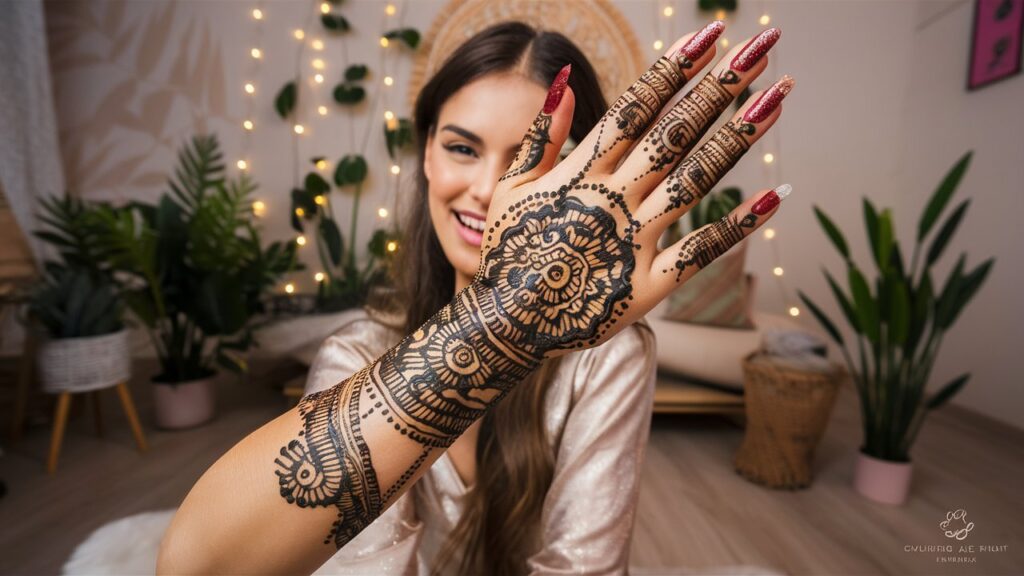The Art of Mehndi Design
Mehndi design, also known as henna design, is an exquisite form of body art with deep cultural roots in the Indian subcontinent, the Arabian Peninsula, and North Africa. Derived from the powdered leaves of the henna plant, Lawsonia inermis, mehndi paste imparts a reddish-brown stain on the skin. This ancient art form is celebrated for its beauty and significance in various cultural and religious contexts.
Historical and Cultural Significance
Mehndi design has been integral to traditional ceremonies and celebrations for centuries. In Hinduism, Islam, and Sikhism, Mehndi is used during significant life events such as weddings, festivals, and religious rituals. It symbolizes joy, beauty, and spiritual awakening, a cherished tradition passed down through generations.

Styles of Mehndi Design
Mehndi’s design boasts a variety of styles, each with unique characteristics and cultural backgrounds. Here are some of the most popular styles:
Arabic Mehndi
Arabic Mehndi is known for its bold, flowing lines and floral motifs. The designs are less dense compared to Indian Mehndi, leaving more skin visible, which creates a striking contrast.

Indian Mehndi
Indian Mehndi is intricate and detailed, often featuring elaborate paisleys, peacocks, and other traditional Indian patterns. The designs cover a significant portion of the skin, creating a dense, ornate look.
Moroccan Mehndi
Moroccan Mehndi is characterized by its geometric patterns and often incorporates Berber symbols. The designs are typically symmetrical and can range from simple to highly complex.

Indo-Western Mehndi
Indo-Western Mehndi is a fusion of Arabic and Indian styles, combining bold lines with intricate details. This style is famous for its versatility and contemporary appeal.
Application and Care
Mehndi is typically applied to the hands and feet but can also adorn other body parts, such as the arms, legs, and back. The application process requires skill and precision, often taking hours to complete intricate designs.

Finding a Reputable Mehndi Artist
Choosing a skilled Mehndi artist is crucial for achieving a beautiful and safe design. Look for artists with a portfolio of previous work and positive reviews. A reputable artist will use high-quality, natural henna paste free from harmful chemicals.
Preparing the Skin
Before applying Mehndi, exfoliate the area to remove dead skin cells. Clean, dry skin helps the henna paste adhere better and stain more evenly. Avoid using lotions or oils, as they can create a barrier that prevents the henna from penetrating the skin.

Caring for the Mehndi Design
To ensure a long-lasting design, follow these care tips:
- Keep the henna paste moist for the first 24 hours using a mixture of lemon juice and sugar.
- Avoid washing the area with soap or shampoo for at least 12 hours after application.
- Protect the design from water and abrasion as much as possible.
The Beauty of Temporary Art
Depending on skin type and care, Mehndi designs typically last several days to a few weeks. The temporary nature of Mehndi allows for frequent experimentation with different styles and patterns, making it a versatile and fun form of body art.

Mehndi in Modern Times
While Mehndi has ancient roots, it remains relevant and famous today. Its appeal has transcended cultural boundaries, with people from various backgrounds embracing Mehndi for its beauty and temporary nature. Mehndi is now a common sight at weddings, festivals, and even fashion shows, where it adds a touch of elegance and tradition.
Natural
One of the critical advantages of Mehndi is its eco-friendly nature. Natural henna paste is made from plant leaves and contains no synthetic chemicals. This makes it a safe and sustainable choice for body art enthusiasts.

Conclusion
Mehndi’s design is a captivating blend of art, tradition, and personal expression. Whether you opt for the bold lines of Arabic Mehndi, the intricate details of Indian Mehndi, Moroccan Mehndi’s geometric patterns, or the Indo-Western Mehndi’s fusion style, there’s a design to suit every taste. By choosing a skilled artist and following proper care tips, you can enjoy the beauty and tradition of Mehndi in all its glory.



